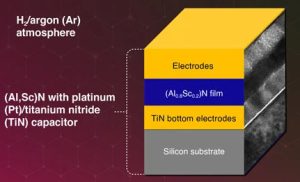“This high stability makes them ideal for high-temperature manufacturing processes under the H2-included atmosphere used in fabricating advanced memory devices,” said the university. “Compared to existing ferroelectric materials, these films maintain their ferroelectric properties and crystal structure even after heat treatment at temperatures up to 600 °C in both hydrogen and argon atmospheres.”
It researchers were looking for something more stable for non-volatile memory than better know ferroelectrics such as PZT (Pb(Zr,Ti)O3) or SrBi2Ta2O9, which can not resist hot hydrogen atmospheres.
“Our results attest to the high stability of the ferroelectricity of the films subjected to heat treatment in hydrogen-included atmosphere, regardless of the electrode material. This is a highly promising result for next-generation ferroelectric memory devices and offers more processing options,” said Tokyo Tech researcher Hiroshi Funakubo.
Two of the characteristics by which ferroelectrics are judged are remnant polarisation (Pr) – polarisation retained after removing the programming electric field – and coercive field (Ec) – the electric field required to programme the material’s polarisation state.
AlScN has a higher Pr (>100µC/cm2) than PZT (30–50µC/cm2), “however, the impact of heat treatment under an H2-included atmosphere on its properties was unclear until now”, said the university, which investigated (Al0.8Sc0.2)N film sputtered onto silicon substrates at 400°C, between electrodes of platinum and titanium nitride.
“Electrodes play a crucial role in the material’s stability, according to Tokyo Tech, with platinum encouraging hydrogen into the film, while titanium nitride blocks it.
The test films were heat-treated for 30 minutes in a hytrogen-argon atmosphere at 800Torr and temperatures between 400 to 600 °C.
X-ray diffraction was used to evaluate changes in the crystal structure through the layers, and electrical tests revealed Pr and Ec.
The films maintained a stable wurtzite-type crystal structure, said the university, with remnant polarisation staying stable at >120µC/cm2, regardless of the electrode or treatment atmosphere, “a value five times larger than HfO2-based films and three times larger than that of PZT”, said the university.
Coercive field increased by ~9%, attributed to changes in the film’s lattice constant that were independent of hydrogen or the electrode material. “The high bond energy between aluminium and nitrogen prevents hydrogen from penetrating the film,” said Tokyo Tech. “Aluminium scandium nitride films are a promising candidate for next-generation ferroelectric memory devices.”
Tokyo Tech worked with Canon Anelva and the Japan Synchrotron Radiation Research Institute.
The work is published as ‘High stability of the ferroelectricity against hydrogen gas in (Al,Sc)N thin films’ in Applied Physics Letters.

